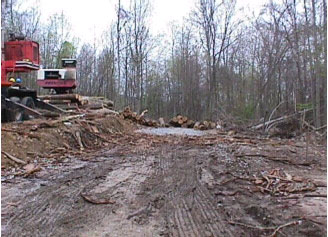
Case: 99WV020-01
Release Date: August 23, 1999
Logging Company Owner Dies After Being Struck by Log That Fell From Logging Truck in West Virginia
SUMMARY
On April 24, 1999, a 46-year-old male co-owner of a logging company (the victim) died of injuries sustained when he was struck and pinned to the ground by a log which had fallen from a loaded log truck. At 8:00 a.m., the victim began assisting his partner who was loading the truck using a knuckle boom loader. The partner left the loader and accessed the truck’s cab. He then asked the victim to direct him as he backed the loaded truck out of the loading zone. The fully loaded truck which was moved prior to securing the load, was being relocated to make room for an empty truck, under contract waiting to be loaded. As the victim’s partner was parking the truck, the victim approached the truck to begin securing the load. He approached one of the binding straps located on the side of the truck. As he did, a log rolled off of the truck pinning him to the ground. An individual who accompanied the empty truck’s driver to the site was standing on the landing and witnessed the incident. The bystander ran to the victim’s partner to inform him of the incident. The partner ran to the victim. It was reported the partner removed the log from the victim’s body by hand. The empty truck’s driver ran to the residence of the land owner and called 911. EMS responded, and he was taken to local hospital and pronounced dead at 9:35 a.m.
The WV FACE Investigator concluded that to reduce the likelihood of similar occurrences, employers should:
INTRODUCTION
On April 24, 1999, the 46-year-old male co-owner of a logging company (the victim) died of injuries sustained when he was struck and pinned to the ground by a log which had fallen from a loaded log truck. On April 26, 1999, the West Virginia FACE Investigator was notified of the death by the West Virginia Division of Forestry (DOF). On April 29, 1999, the WV FACE Investigator conducted an on-site investigation. The Investigator reviewed the incident with the West Virginia Division of Forestry representative as well as the timber procurement company’s forester, who then both accompanied the Investigator to the site. The surviving co-owner was interviewed at the site. The site, truck, and log were examined and photographed. Other informational sources and contacts included: the bystanding eyewitness, death certificate, medical examiner’s report, and newspaper articles.
The employer in this incident was a co-ownership company that had been in business for seventeen years and employed four employees. The company was owned by the victim and his partner. Both owners were present the morning of the incident as well as a non-company contracted truck, the truck’s driver, and his friend. The incident occurred on a non-routine Saturday morning loading operation. There were no other operations being performed that morning other then loading. Total number present during above loading operation was four. This particular 50-acre unmarked timber stand was being selectively harvested for a timber procurement company as saw timber.
The victim and the co-owner held Certified Logger status in West Virginia. [Note: The Logging Sediment Control Act of West Virginia (1992) requires that each timbering operation in West Virginia be supervised by a certified logger. To become a certified logger, an individual is required to successfully complete training and pass a test for best management practices (a soil erosion prevention plan) and chain saw safety and possess a current firstaid card (1)].
There was no formal company written safety program or company, site, and task-specific safety training. The surviving co-owner had been hospitalized three years earlier after being hit by a log which had rolled off of a truck. In addition, five years earlier, the company had experienced a fatality involving a tree feller who was struck by a tree.
The victim’s job at the time of the incident was assisting the loading operation by directing the truck while backing up and then securing the load. Reportedly, the non-routine Saturday morning was only to take a few hours.
INVESTIGATION
On Saturday April 24, 1999, the co-owners of a logging company
met at their operation’s landing site for a short term, non-routine Saturday
morning loading operation. The operation began at approximately 8:00 a.m. It
was a clear and cool day. A total of four individuals were present the morning
of the incident. The two co-owners were loading their company’s log truck
while a truck under contract, its driver, and a friend waited for their turn.
The landing area was clean, open, and level (see Figure 1).
The logging truck was loaded using a knuckle boom loader. The victim had assisted
his partner who was loading their truck. After their truck was fully loaded,
the victim’s partner left the loader and climbed into the truck’s
cab. He then asked the victim to direct him as he backed the loaded truck out
of the loading zone. The fully loaded truck, which was moved prior to securing
the load, was being relocated to make room for the truck in waiting(see Figure
2). At approximately 8:45 a.m., as the victim’s partner was parking
the truck, the victim approached the truck to begin securing the load. He approached
one of the binding straps located on the side of the truck (see Figure
3). As he did, a log rolled off of the truck pinning him to the ground (see
Figures 4&5). An individual who
accompanied the empty truck’s driver to the site was standing on the landing
and witnessed the incident. The bystander ran to the victim’s partner
to inform him of the incident. The partner ran to the victim. It was reported
the partner removed the log from the victim’s body by hand. The empty
truck’s driver ran to the residence of the land owner and called 911.
The victim had experienced multiple traumatic injuries as a result of being
struck by the falling log. EMS transported the victim to a local hospital where,
at 9:35 a.m., he was pronounced dead.
CAUSE OF DEATH
The medical examiner’s report listed the immediate cause of death as multiple, traumatic injuries.
RECOMMENDATIONS/DISCUSSION
Recommendation #1: Employers should ensure that the height of the stacked logs does not exceed the height of the standards on the truck.
Discussion: In this incident, the victim approached a truck whose load was stacked higher than the vehicle’s stakes or standards (see Figure 6). Loads which have logs resting above the truck’s stakes are inherently unstable. Stacking the load higher than the truck’s standards also by passes the vehicle’s integral safety device (the standards). OSHA Regulation 29 CFR 1910.266(h)(6)(v) requires that the load shall be positioned to prevent slippage or loss during handling and transport (2). Loading the truck within its safe limits would have prevented this incident by allowing the truck’s standards to prevent or arrest the movement of the logs.
Recommendation #2: Employers should ensure that stacked logs are secured immediately
after the loading operation is complete prior to moving the truck.
Discussion: In this incident, the truck and its unsecured load had been moved approximately 100 feet. Unsecured log loads are inherently unstable and more so when moved. CFR 1910.266 h(6)(iv) requires that each log be placed on a transport vehicle in an orderly manner and tightly secured (2). Securing the load at the time the loading operation was completed might have prevented this fatal injury from occurring. Securing the logs as soon as possible and prior to moving shortens the duration of time that potential log movement and employee exposure can exist.
Recommendation #3: Employers should develop, implement, and enforce a written
safety program which includes, but is not limited to, task-specific safety procedures
and worker training in hazard identification, avoidance, and control.
Discussion: The evaluation of tasks to be performed at the work site form the basis for the development, implementation, and enforcement of a safety program as well as task-specific safety procedures. The key elements of the program should include the communication of task-specific safe work practices and, at a minimum, training in hazard identification and the avoidance and abatement of these hazards. In this incident, the victim was fatally injured when he approached an unsafe operation (logs being stacked above the truck’s standards and being moved prior to securing). Training in the hazards associated with the work environment and task-specific safety procedures via a comprehensive safety program would have given the victim the knowledge necessary to recognize and avoid a hazardous situation. CFR 1910.266 (I)(3)(iii) requires that workers be trained in the recognition of safety and health hazards that are associated with their assigned job tasks, including the use of measures and work practices to prevent or control these hazards (2).
Recommendation #4: Manufacturers and employers should consider manufacturing
and/or retrofitting log trucks with retention stakes high enough to adequately
secure anticipated log loads.
Discussion: Although the majority of the loads placed on logging trucks fall within acceptable state and federal height and weight parameters, they often exceed the height limitations of the truck’s retention stakes. In this incident, a log rolled off the top of the load which was above the top of the stakes. Retention stakes which extend above the top of the logs during maximum capacity loads--assuming the stakes are properly constructed--would help to secure the load during all phases of load handling.
ILLUSTRATIONS
 |
|
Figure 1. Clear, open, and level landing area. |
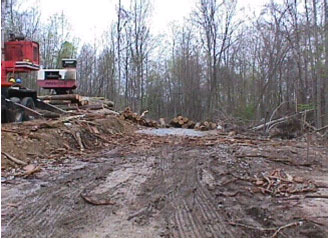 |
| Figure 2. Arrow in foreground
represents area where truck was loaded. Arrow in background indicates
area were fully loaded unsecured truck was moved to and approached by
victim. |
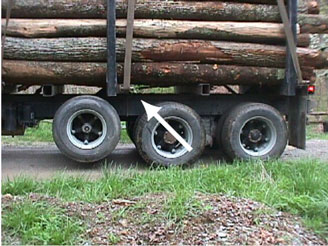 |
| Figure 3. Arrow indicates
binder being accessed when log struck victim. |
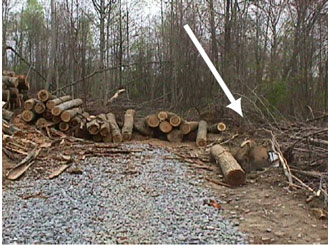 |
| Figure 4. Truck was backed
into this area. Arrow represents path and points to fatal energy source. |
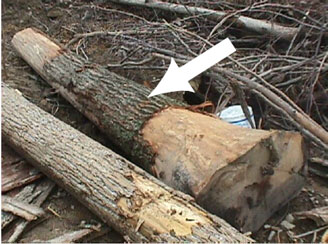 |
|
Figure 5. Arrow points to fatal energy source. Log
was 12 feet long and estimated to weigh 1,000 pounds. |
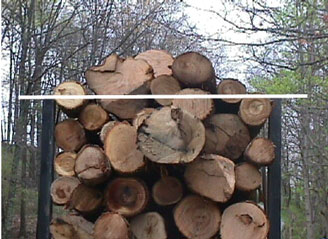 |
|
Figure 6. This is the rear view of the same truck
loaded the day of the investigation. White line represents the plane created
by the top of the standards. Note the height of logs above the line. |
FATALITY ASSESSMENT AND CONTROL EVALUATION PROGRAM
The WVU Center for Rural Emergency Medicine, through a contract with the West Virginia Department of Health and Human Resources, conducts investigations on the causes of work-related fatalities within the state. The goal of this program is to prevent future, fatal work-place injuries. West Virginia FACE intends to achieve this goal by identifying and studying the risk factors that contribute to work-place fatalities, by recommending intervention strategies, and by disseminating prevention information to employers, employees, trade associations, unions, equipment manufacturers, students, teachers, and others with an interest in work-place safety.
Please use information listed on the Contact Sheet on the NIOSH FACE website to contact In-house FACE program personnel regarding In-house FACE reports and to gain assistance when State-FACE program personnel cannot be reached.